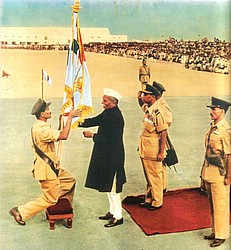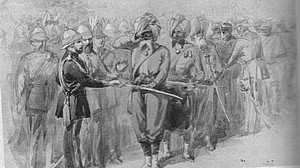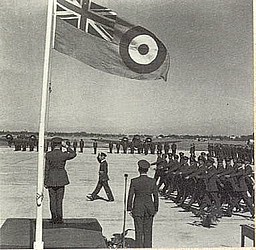
Flg Offr Sudhakaran receives the IAF colours from the president on 01 Apr 54. Air Mshl S Mukherjee, the first Indian Chief of Air Staff salutes the uncased colours. Flg Offr Sudhakaran was selected for this unique honour as he was a particularly outstanding officer. He was later killed while test flying a Gnat at A&ATU in 1959. This hand coloured picture has erroneously depicted the shoes as brown, they have always been black.
Origins of Saluting
The origin of saluting as a military act is obscure Major TJ Edwards in his book “Military customs” suggests that‘saluting and the paying of compliments may be said to proceed from the exercise of good manners’. We usually think of a compliment as a pleasantry, a pleasing comment.In the military, compliments are given very much for similar reasons; for respect. A salute between an officer and service person is a sign of mutual trust and respect. It is a privilege granted only to members of a service to use this form of greeting. They are always initiated by the junior rank acknowledging the senior rank. Salutes indicate a willingness to serve and smart saluting indicates a high degree of deportment.
One of the more romantic theories to emerge from the medieval west was that victors of tournaments, when receiving their prize fromthe queen, shaded their eyes with their hands, rather than be blinded by the queen’s dazzling beauty. More believable is the suggestion that, like the handshake, the salut ealso has its origins in offering the open palm, devoid of weapon, as a gesture offriendship or at least friendly intention. In Europe of the Middle Ages when Knights meteach other, a peaceful greeting was to doff their helmets or lift their visors. The‘Chronicles of Froissart’ dated 1345, state that “when Sir Argot saw them, he took off his cap and saluted them”. From historical records, two practices seem to emerge, the offering of the open hand and the raising of the hand to uncover the head. If these two gestures are combined into one, the origin of today’s hand salute becomes a little clearer. This form of uncovering the head continued until a regimental order of the Cold Stream Guards directed the men “not to pull off their caps when they pass an officer or speak to him, but clap their hands to their hats and bow as they pass him”.This amended form of salute seems to have caught on with many other foot regiments of the English Armies despite the fact that it was not officially approved. The cavalry regiments and the horse guards were not so keen but by 1762 the wear and tear caused by the constant doffing and donning of headgear had become of great concern and it was ordered that “….the men in the future are only to briskly raise the backs of their hands to the hat when passing an officer”. This practice was later adopted as a standing order published in the ‘Rudiments of war’ dated 1777. By the early 19th century the salute further evolved with the open palm to the front and has since remained an established form of salute.
The evolution of the custom of saluting in India is a bit more blurred till at least the 17th century. There is no ready documentation on the manner in which respect or compliments were paid to military officers of higher rank in medieval India. Although a brief look at historical and epic films of the 60s and early writings seems to indicate that bowing and kneeling (on both knees as opposed to one knee in Roman or Gallic times) were standard forms of such salute, especially to royalty, little can be said of any particular form of salute using the hand. Folding of the hands in the classic Hindu gesture of greeting and the Islamic gesture of using the right hand to wish ‘Salaam Ale kum’ were almost certainly widespread in the Mogul armies at the turn of the 17th Century. Surprisingly the Islamic form of greeting comes closest to the ‘open palm touching the cap’ form of salute.
By the time William Hawkins dropped anchor off Surat and raised the British flag in India on 24 Aug 1608, the Portuguese had already won favour with the court of Jehangir. Hawkins set out for the Great Mogul’s court in Agra and armed himself with fifty “of the most ferocious Pathans” to defend himself against the Portuguese. These must certainly be the very first British trained troops in India. Although commonly believed, it was not only the British that formed and trained Indian troops in India. The Dutch, the French and the Portuguese had already setup small militias for their own defense. By 1623, under the diplomacy of Sir Thomas Roe,the King’s Ambassador to the court of Aurangzeb, the British had set up ‘factories’ at Surat, Broach, Ahmedabad, Agra, Masulipatnam and Bramport(Burhampur). They then began the systematic training and drilling of local levies todefend their interests. By the middle of the 18th century every power in India was awarethat both the French and the British had a military secret, which enabled them to triumph over superior forces. This was the system of drill and training. If neither could be persuaded to join a prince or his ally, the next best thing was to persuade a French or British officer to join his service and train his troops. As early as 1757, the Maratha chief Balaji Baji Rao, the Peshwa, was defeated by the troops of the Nizam trained by the French soldier Count de Bussy. All through the wars against the expansion of the British East India Company and later the British Government from 1859, Indian princes and allies used the help of one European power against the other. Hydar Ali and later his son, TipooSultan, the Tiger of Mysore, received training and equipment from Napoleon through the port of Mangalore. The Sikh Armies under Ranjit Singh and later the child King Dalip Singh were almost wholly trained by the French, wore French uniforms and even gave words ofcommand in French. Rani Laxmi Bai’s forces at the siege of Jhansi had artillery manned by French Gunners and mercenary British officers. By 1945 The Indian Services numbered some 2, 75,000, the greatest volunteer army ever raised, and each one of those men and women were trained and drilled by the British in British customs and military etiquette. The crisp, stiff and exact hand salute remains the greatest of those minutiae of tradition left behind by the British
Saluting in the Indian Air Force
The origin of the custom of saluting in the Indian Air Force comes, quite clearly, from the practices of the RAF under whose wings it rose in 1932. The RAF itself was formed by royal dictat in 1918 from the Royal Flying Corps(RFC) (itself an adjunct of the cavalry units of the Royal Army) towards the end of the first Great War. No wonder then that most of the customs adopted by the RAF and then on by the Indian Air Force came from the Royal Army. Later peculiar customs of the RAF (so correctly carried on by the IAF) including the wry, self effacing humour and camaraderie of the pilots, the characteristic élan displayed by all ranks of the RAF and later the IAF, were born in the desperately hopeless circumstances of Aug 1940 during the Battle of Britain and later the desperate battles in Assam.
Hand Salute and other forms ofpersonal saluting
The IAF hand salute is exactly like that ofthe Indian Army, with the open palm forward and the fingers and thumb together and the middle finger almost, but not touching the hatband. The Naval hand salute, also derived from that of the Royal Navy, is different, where in the palm of the hand is not exposed and faces towards the shoulder. Its origin lies in the days of sail when copious amounts of pitch and tar were used to seal the timber hull from seawater. To protect their hands seaman wore white linen gloves but these got dirty and to prevent their dirty gloves frombeing seen, the hand was moved 90 degrees to become today’s naval hand salute.
The hand salute is only one form of saluting; others have the same intention, to signify peaceful intention. In the’present arms’ position, the rifle is placed in a position where it can do no harm and is being presented away from the body as if ‘giving it away’. The sword salute points the sword tip downwards rendering the body defenseless. This form of salute is almost obsolete in the IAF as no uniform currently worn, includes the sword; it is only worn by the cadet commander of the passing out parade at the Air Force Academy to accept the Nawanagar sword of Honour. In the modern day formation fly past, aircraft fly low and slow and together in an almost ‘defenseless’ manner.
Gun Salute
The firing of gun salutes in honor of the President or Governors or to mark a special occasion is a very old custom. This custom first developed in ships at sea. In the days of sail, the guns of a ship rested at portsalong the length of the gun decks. The guns were often kept fully loaded and ready foraction. Firing them in salute meant that for the length of time it took to reload the guns the ship was virtually defenseless. This action showed friendly intent. As an aside, the British in their “do-gooding” days of trying to curb the Sati in India, offered to fire as many guns as a prince had wives when he visited the Governor General if he accepted to abolish sati in his princedom. But as Philip Mason writes, it was a tame substitute and eighty-four women died with maharaja Budh Singh of Bundi, sixty-four with Ajit Singh of Jodhpur and numbers upwards of twenty were usual in the 1830s. Normally odd numbers of guns are fired with twenty one being the maximum for the President.
Another development is the turning of one’s eyes to the right and looking into the eyes of the reviewing officer. When knights passed serfs in medieval times, the serfs lowered their heads as a token of respect. However, if they were the fighting men of the castle who followed the knights in war, they were allowed to look their superior in the face. Theirs was the honour due to the fighting men. Eyes right is a continuation of this privilege. Saluting with colours and standards dates back to the 17th century. An extract from a military work in 1639 states: “ if a king or great prince passeth by, the ensign (colour bearer) is to veil his colours close to the ground with his knee bending in token allegiance and submission”. In 1799 this practice was officially recognized in the Royal Army and continues today in the IAF. Saluting with the colours is exclusively reserved for the President however, when the IAF colours are paraded at the Air Force day parade, all members of the armed forces are to salute and those in civilian clothes to come to attention.
Similarly whenever the national flag is hoisted or lowered, or when the national anthem (including that of a foreign country) isplayed, all ranks in view are to face the flag and salute. Another modern custom is to salute when entering an office of another officer regardless of whether he is senior or junior. The origin of this custom is obscure but is in the best traditions of chivalry.Similarly, a custom not officially approved, is the saluting of Prisoners of war (PoW)senior in rank to ones self. This once again is a tradition reflecting entirely, the chivalry of the service.
Missing Man formation
One of the rare American customs to enterthe IAF recently is the flying of the “missing man” formation. This form of salute calls for a four aircraft formation to run in, in finger four, and as the formation comesin view of the saluting stand, No 3 peels off symbolizing the departing of the missing-man. As the formation crosses the saluting stand the empty slot is clearly visibleand the reviewing officer leads all present on the ground to salute all those men and women of the IAF who were lost in the line of duty.
 |
The IAF’s first ever missing man formation was flown using three MiG-21s at a ceremony just after the Kargil War. |
The custom of saluting all commissioned officers of all the three forces comes from the commission granted them by the President of India. Thus when a subordinate airman salutes an officer he is indirectly acknowledging the head of state. A salute returned is on behalf of the President. The military code of conduct states that all officers entitled must be saluted. Sometimes it may not be safe orpossible for it to be returned. But every effort must be made by the officer to acknowledge the salute. This is the reason why an officer always sits in the left hand rear seat of a staff car, so he can return a salute with his right hand. Interestingly, it was possible up till 1918 to give a salute with either the left or hand in the British army. Today a salute with the left hand is only given when the right is incapacitated. It has also long been a custom of the IAF to salute all ladies at any time, as it is to salute when being passed by a funeral cortege. Another custom is that when an aircraft taxys out, the marshaller salutes the captain of the aircraft and then receives a reply.This tradition began in the RFC in the first war when the average life expectancy of a new pilot was twenty minutes in the air (they were called “the twenty minuters”).
The salute represents one of the oldest traditions in the military and should never be considered a servile act. A French writerput it thus, “The salute and other military compliments have their own raison d’être. They encourage a proper pride in the uniform, they effectively combine discipline with proper respect due superiors, while at the same time elevates the soldier in his own eyes by reminding him of all that is implied by the profession of arms and its traditions of chivalry and courtesy”.



